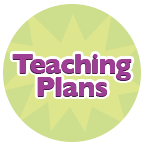The game of Copycat is a movement game that also incorporates the use of descriptive language. While music is playing, one partner copies the movements of another. After moving to music, partners explain what they were doing with their body. This activity develops vocabulary pertinent to body parts and movement and encourages students to retell events in sequence.
Materials:
– instrumental music with a strong beat
Grouping: whole class in partners
Introducing the Game
- Model the game procedure with a partner.
- Pair students to work together and reinforce the steps to the game.
- Play music for 30 seconds so Partner A can perform movements.
- Ask Partner A to tell what he/she was doing with his/her body.
- Ask Partner B to describe something else Partner A was doing.
- Encourage students to expand oral language descriptions and provide additional vocabulary, if needed.
- Repeat the activity for Partner B.
- Invite pairs of students to demonstrate their movements and descriptions in order to elicit and expand vocabulary.
Playing the Game
- Decide who will move first (Partner A) and who will be the copycat (Partner B).
- Partner A listens to the music and then moves in some way.
- Partner B tries to copy the movement.
- Partner A tells what he/she was doing once the music stops.
- Partner B describes something else that Partner A was doing.
- Change roles so that Partner B is the mover and Partner A is the copycat.
Variation: Statue
- The game of Statue encourages listening, enhances body awareness, and provides practise with descriptive oral language. In this game, instead of moving to the music, Partner A is a sculptor who directs the movements of Partner B, the statue. Partner A gives directions (e.g., “First put your hand on your head. Then move your right foot forward. Finally bend forward at the waist.”). Then the statue holds the position for ten seconds. The next part of the game emphasizes sequencing and descriptive language. The statue is asked to shake loose of the position, reposition using the same movements, and describe the position (e.g., “First you told me to put my hand on my head. Then you asked me to move my right foot forward. Finally you asked me to bend forward at the waist.”). Partners then switch roles and repeat the process.
* Adapted from Encouraging Early Literacy in a Child-Centered Kindergarten Classroom: Resource Handbook by Judy Ellis, Bureau of Education and Research, Bellevue, WA, 2002, pp.23-24.
